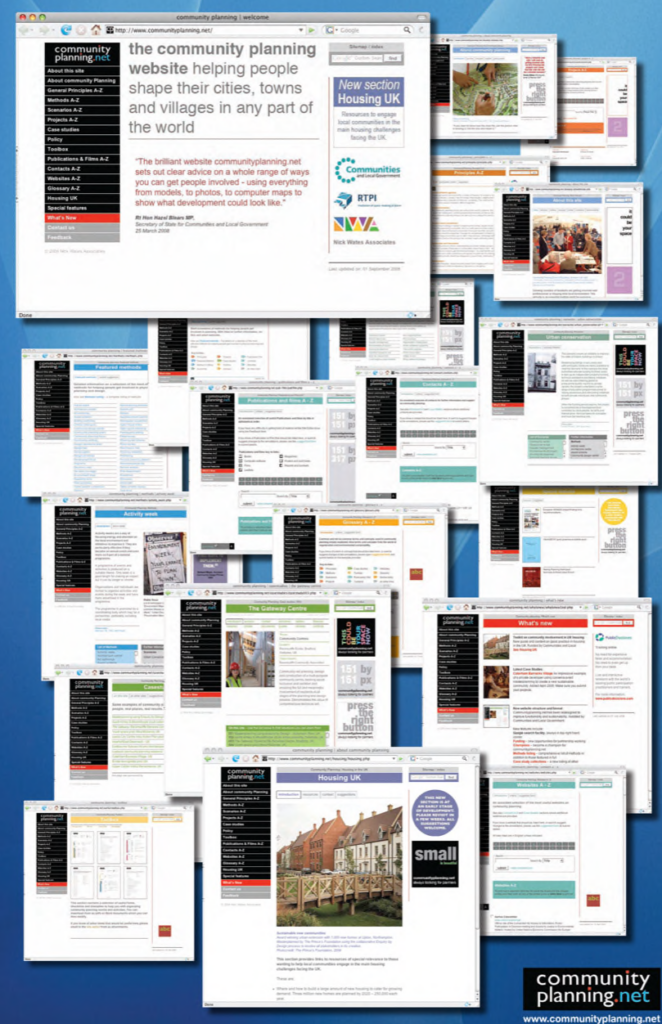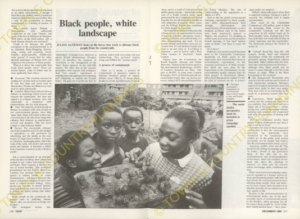by Dr Nick Wates
The Community Planning Website, or Communityplanning.net as it is more helpfully called, was born in 1998 at the offices of the Department for International Development (DFID) in Central London. A steering group meeting of a project which produced The Community Planning Handbook; how people can shape their cities, towns & villages in any part of the world[1] was signing off a final draft of the book when Michael Mutter, Senior Architectural & Physical Planning Advisor, suddenly said “You do know that this book is really a website don’t you?”[2]
‘Communityplanning.net‘s logo designed by Keith Gilles in 2000.
The drive to create both the handbook and website originated from my directing an urban conservation project in Hastings. We had a shopfront office on the High Street and were deluged with local people wanting information on how to improve their buildings and neighbourhoods. Not theoretical texts or dubiously relevant case studies which was mostly what was available, but simple, universally applicable, nuts-and-bolts information on neighbourhood regeneration which would stop people having to constantly ‘reinvent the wheel’.[3]
The format for collecting and communicating the good practice guidance emerged from live action research facilitated by the New Economics Foundation, the Urban Design Group and The Prince of Wales’s Institute of Architecture. Dozens of pilot community-led planning initiatives were organised, monitored and evaluated in a variety of contexts and in different parts of the country.[4] The style for communicating the results was how-to-do-it advice based on the ‘less is more’ principle of using minimal text with maximum use of visuals (photos and illustrations).
The Handbook was published to much acclaim in 2000 and DFID agreed to fund a companion website. This was in the days when the internet was still seen optimistically as a benevolent tool for sharing knowledge rather than the commercial platform riven with traps for the unwary that it has since become. A condition of the funding was that the contractor, i.e. me as Editor and website owner, had to have copyright of the material. By virtue of having created it I did have copyright of all the material on the website at that time. Later on we adopted the practice of joint copyright for material contributed by others. I engaged web designer, Keith Gillies, who gave Communityplanning.net the same clean, functional, colourful style as Jeremy Brook, another Hastings based designer, had given the book.
DFID was keen that the website should be sustainable, so from the outset we had a right hand column for advertisements and signed up for Google ads. This gave the impression that the site was a commercially viable concern but sadly, as for many other information sharing websites, sufficient advertising was not forthcoming to pay for the amount of editorial and design work required.
But attracting sponsorship did prove successful and enabled Communityplanning.net to grow rapidly in the first few years. A new, sophisticated case study section was funded by The Royal Town Planning Institute. The Academy for Sustainable Development funded a massive increase in the number of listings and English Partnerships, The European Union, The Prince’s Foundation, The Environment Agency, the Town & Country Planning Association and the Building & Social Housing Foundation all helped by funding specific features. Numerous individuals and organisations contributed text and photographs for case studies and listings.[5]

After almost ten years the site was beginning to mature and was selected as a Finalist in the 2009 Royal Town Planning Institute Awards for advancing ‘significantly the science and art of town planning’. Together with the Handbook it had provided a taxonomy for classifying and explaining an activity that had previously been hard for many people, even some of those doing it, to understand.
The website’s value seemed to be recognised in 2011 when Communityplanning.net was invited by Locality to become part of a Building Communities Consortium for delivering the UK government’s neighbourhood planning agenda. A first year of funding enabled substantial upgrading and updating of Communityplanning.net and evaluation showed that the site was much appreciated by those embarking on neighbourhood planning.[6] By this time the website included detailed, illustrated information on 60 methods of engagement, 52 general community planning principles, 22 common community planning scenarios and 14 case studies. There were 218 annotated publication listings, 151 website listings, 916 glossary items explained and listings for 192 useful organisations and 58 consultants.
Sadly, Locality abandoned the Consortium after the first year and decided not to continue funding Communityplanning.net. This led to it being impossible to keep the website up to date, a problem that persists to this day.
In 2014 much of the new material on the website was incorporated into a second edition of The Community Planning Handbook, cementing the mutually supportive relationship between the web and paper versions of the material.[7]
In 2020 research concluded that ‘since being launched in 2001, Communityplanning.net has consistently been Google’s No 1 result for a search on ‘community planning’. In the last ten years alone over a quarter of a million people have visited the website and collectively spent a total of 706 days looking at its content. Although the majority of users have been from the UK and USA, the audience has been truly international; from all parts of the inhabited world. It is also clear that all the main sections of the website have been well used. Web user analysis reveals some interesting facts, for example that the cities with the third and fourth highest audience ratings are Manila and New Delhi; rapidly developing cities with problems of liveability. Communityplanning.net has over 5,000 backlinks (i.e. links to the site) from 374 different UK and international websites.’[8]
So what is the state of play now in 2023? I am over 70 years old and need to retire. I no longer have the capacity to keep the website up to date let alone continue to improve it. But many organisations and individuals have helped build the website and people all over the world have been finding it useful.[9] While other ways of communicating about community-led planning may also be valid, the taxonomy developed by the Community Planning Website and related books works well.
The Spaces of Hope project is an ideal opportunity to give the Communityplanning.net website a new lease of life and ensure the sustainability of its resources.
Dr Nick Wates is the Editor and Owner of Communityplanning.net and Managing Director of Nick Wates Associates. He is a Community Fellow at the University of Brighton.
[1] Wates, N. (2000) The community planning handbook: how people can shape their cities, towns and villages in any part of the world. Earthscan. London. http://www.nickwates.com/wp-content/uploads/2018/07/Community-Planning2000LoRes.pdf
[2] DFID project R7141 Action Planning in Developing Countries.
[3] Wates, N. (1991) Turning the tide: Hastings Trust prospectus and review 1991, Hastings Trust. http://www.nickwates.com/wp-content/uploads/2015/05/Turning-the-Tide-A3.pdf
[4] Wates, N. (1998) ‘Involving local communities in urban design; promoting good practice, a special report on the Urban Design Group’s public participation programme,’ Urban Design Quarterly, 67(July), pp. 15-38. http://www.nickwates.com/wp-content/uploads/2015/05/UDQ-July-98-04spreads.pdf
[5] See the Credits tab at http://www.communityplanning.net/aboutcp/aboutthissite.php
[6] Bragman, P., Ahmed, S. and Taylor, M. (2012) Evaluation of the Building Community Consortium Supporting Communities and Neighbourhoods in Planning Scheme, Final Report. http://www.communityplanning.net/neighbourhoodplanning/pdfs/120517BCCFinal.pdf
and Communityplanning.net, Evaluation report endorsements for communityplanning.net
http://www.communityplanning.net/neighbourhoodplanning/pdfs/02BCCEvaluationHighlightsCPW120712.pdf
[7] Wates, N. (2014) The community planning handbook: how people can shape their cities, towns and villages in any part of the world. Rev. edn. Routledge. https://www.routledge.com/The-Community-Planning-Handbook-How-people-can-shape-their-cities-towns/Wates/p/book/9781844074907
[8] Wates, N, Making Places Better, PhD thesis, University of Brighton, 2020, p45. http://www.nickwates.com/wp-content/uploads/2020/03/WatesNickthesis20200226final.pdf
[9] See endorsements tab. http://www.communityplanning.net/aboutcp/aboutthissite.php


